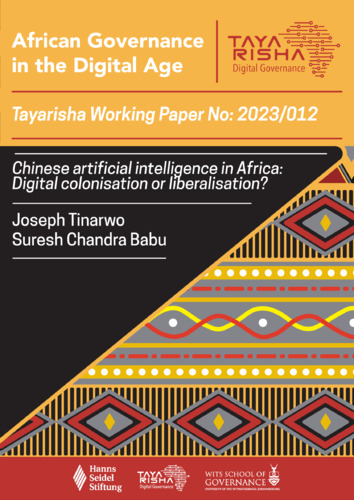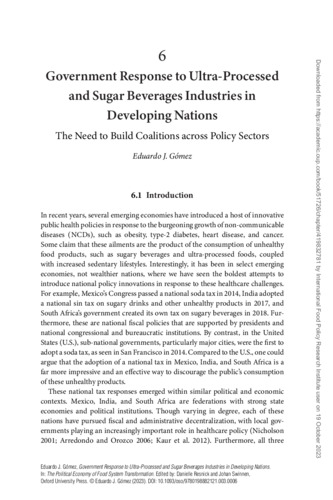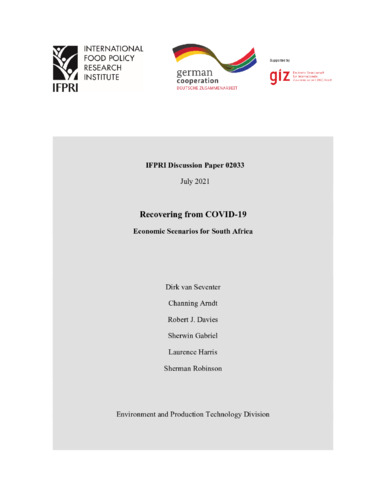Recovering from COVID-19: Economic scenarios for South Africa
As the South African economy emerges from the downturn induced by COVID-19, makers are concerned with recovery, reconstruction, and transformation. This paper focuses on the recovery from the severely depressed levels of economic activity that occurred in April 2020. However, before considering the period after the economic trough of April 2020, a mention of economic conditions prior to the pandemic is worthwhile. In brief, economic performance was terrible by almost any metric. Furthermore, economic performance had been poor since 2008, with evidence pointing to ongoing deterioration culminating in the fourth quarter of 2019, when per capita GDP contracted, unemployment ticked upwards to its highest level since 1994, productivity declined, and inequality worsened. The striking difficulties of the South African economy in avoiding/absorbing shocks-whether internally generated, such as shocks to electricity supply, or externally generated, such as changes in terms of trade or investor sentiment in relation to emerging markets-have been an integral part of this disappointing economic performance over time. In short, the situation prevailing prior to the onset of the COVID-19 pandemic was one of economic weakness. Beginning from this position of weakness, the economic shock related to COVID-19 was enormous, likely the largest single economic shock in the history of South Africa. According to official statistics, GDP in the second quarter of 2020 was approximately 17% below the level registered in the second quarter of 2019. In assessing this shock, it is important to recall that GDP is a flow concept. One can, in principle, consider the volume of flow over any arbitrary period: a day, a week, a month, a quarter, a semester, a year, and so forth. The lockdown associated with COVID-19 precipitated an extraordinarily rapid decline in economic activity. Indeed, the available analytics and data point to a trough in economic activity, or flow value of GDP, at less than 70% of the level that would have pertained in the absence of the pandemic, or a greater than 30% decline in the flow rate of GDP (Arndt et al 2020). If we accept a 17% reduction as the average flow rate of GDP over the quarter and we accept that the economic shock related to COVID-19 was unprecedently rapid and drove a decline in the flow value of GDP of much more than 17% at the trough (which probably occurred sometime in late April or early May), then we must also accept a rapid recovery in economic activity in May and June in order to achieve an average decline of 17% over the quarter. Furthermore, this relatively rapid recovery continued. GDP in the third quarter of 2020 was “only” about 6% below the levels recorded for the third quarter of 2019, with the corresponding figure for the fourth quarter at about 4%. Other figures, including recent ones, broadly support this basic story. For example, retail sales in February 2021 were up 2.4% year-on-year, with the previous two months, January and December, having registered only a slight decline year-on-year. Correspondingly, manufacturing production and sales were down by 2.1% in February 2021 year-on-year. A few broad observations emerge from this history and the available data. First, the South African economy has exhibited more resilience to the COVID-19 shock than performance up to December 2019 might have led one to expect. In Mexico, for example, the distance between fourth quarter GDP in 2020 and that in 2019 was greater than for the same comparison in South Africa. At the same time, Mexico registered close to twice as many deaths related to COVID-19 per million population as South Africa. Second, multiplier effects are important. As discussed in Arndt et al (2020), multiplier effects accounted for the bulk of the initial economic contraction. However, they also operate positively, buoying the recovery experienced to date and bringing economic activity back towards the levels of 2019. Third, while having GDP about 4% down year-on-year is much better than the 17% decline observed in the second quarter, 4% down is still a deep recession by ordinary standards. While some sectors are producing at close to levels observed in the fourth quarter of 2019, others are more strongly affected. The incidence of these depressed levels of economic activity remains likely to be tilted toward lower-income households, which are more vulnerable to begin with. Overall, there remains substantial slack in the economy, multiplier effects still apply, and many households remain deeply vulnerable to severe economic hardship.
Authors
van Seventer, Dirk Ernst; Arndt, Channing; Davies, Rob; Gabriel, Sherwin; Harris, Laurence; Robinson, Sherman
Citation
van Seventer, Dirk; Arndt, Channing; Davies, Rob; Gabriel, Sherwin; Harris, Laurence; and Robinson, Sherman. 2021. Recovering from COVID-19: Economic scenarios for South Africa. IFPRI Discussion Paper 2033. Washington, DC: International Food Policy Research Institute (IFPRI). https://doi.org/10.2499/p15738coll2.134455.
Country/Region
South Africa
Keywords
Sub-saharan Africa; Africa; Southern Africa; Shock; Policies; Covid-19; Gross National Product; Quarantine
Access/Licence
Open Access
Project
Policies, Institutions, and Markets









